AC Milan scored a stoppage-time winner to grab a 3-2 away win at Udinese. The victory, however, was overshadowed with Mike Maignan being subjected to racist abuse by a group of home fans, prompting the match to be suspended briefly during the first half.
At the point in which the game was paused Milan were leading 1-0, but shortly following the resumption of play Udinese equalised. The home team then took the lead just past the hour-mark before the visitors staged a late comeback with goals in the 83rd and then 93rd minutes.
Ultimately, the result, and how the game unfolded on the pitch, is insignificant and unimportant when an appalling incident such as racism occurs. So whilst merely trivial in the wider context of the match, here are some tactical observations from @Tactics_Tweets.
Set-ups and gameplans
Pioli named the same starting eleven to the one which beat Roma a week prior. Systematically and stylistically, Milan were also similar when attacking and defending.
During build-up phases the away side used a base of six players, consisting of their back four and a double pivot of Yacine Adli and Tijjani Reijnders.
Ahead of this base was Ruben Loftus-Cheek, operating in the pockets of space in behind and in between the Udinese midfield line, and the three Milan forwards who were most advanced, occupied the opposition backline.
Milan would have expected to dominate the ball in this game, not only because Pioli wants his side to control games in this way, but also because Udinese currently rank lowest for possession across the league this season (41.7% average). The visitors’ offensive gameplan, therefore, was to manipulate the Udinese defensive block to create gaps that could be first bypassed and then exploited.
Out of possession, Gabriele Cioffi’s side sat in a 4-4-2 mid-block. The hosts were comfortable allowing the opposition centre-backs to have possession. The two Udinese forwards, Lorenzo Lucca and Roberto Pereyra, were tasked with blocking vertical passing lanes through central areas of the pitch.
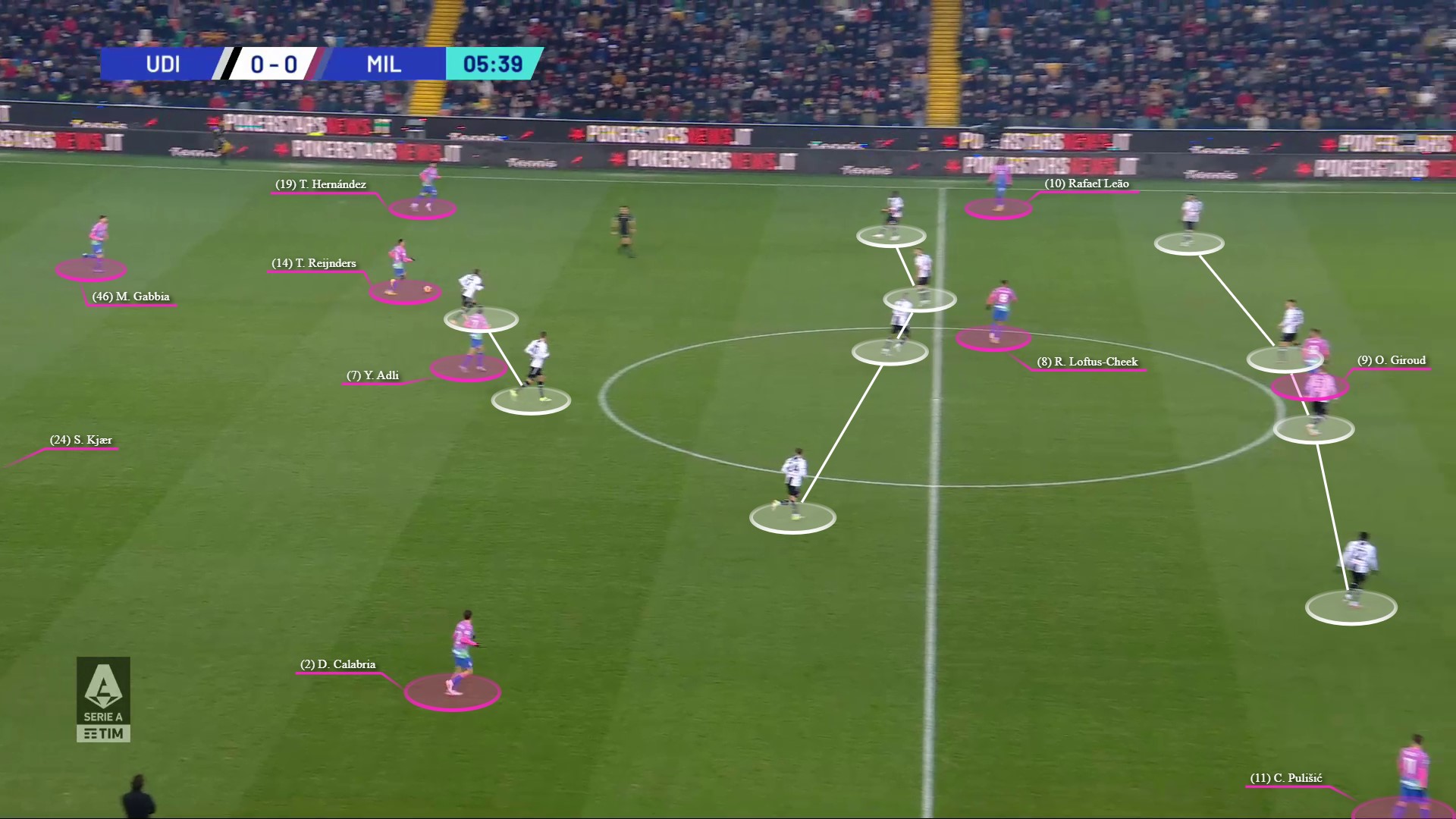
The home side aimed to funnel Milan’s play into wider areas where the ball-side half of the team would squeeze over to that flank to lock in their opponents and then look to force turnovers.
The two wide Udinese midfielders (Festy Ebosele on the right and Lazar Samardzic on the left) appeared instructed to both engage and track the Milan full-backs which allowed the Udinese full-backs to focus on covering Rafael Leão and Christian Pulisic.
In defensive phases, Milan’s main challenge would be dealing with Udinese’s fast and direct style of play. In 2023/24, the home side ranks quickest for Direct Speed (a measure of how quickly a team progresses the ball upfield) and lowest for Passes per Sequence (the average number of passes per sequence) in Serie A.

One way in which Milan tried to protect themselves against this Udinese threat was by maintaining coverage using the six players in their build-up base.
Even though the Milan double pivot and full-backs each had license to get further forward in attacking phases – with the two centre-backs always deepest – Milan aimed to ensure that between these four players there was at least one player behind the ball and the others in close proximity to counter-press or retreat if needed.
When Udinese were in possession, or had the opportunity to attack following a turnover, their system would switch into a back three, with Hassane Kamara pushing upfield from left-back.
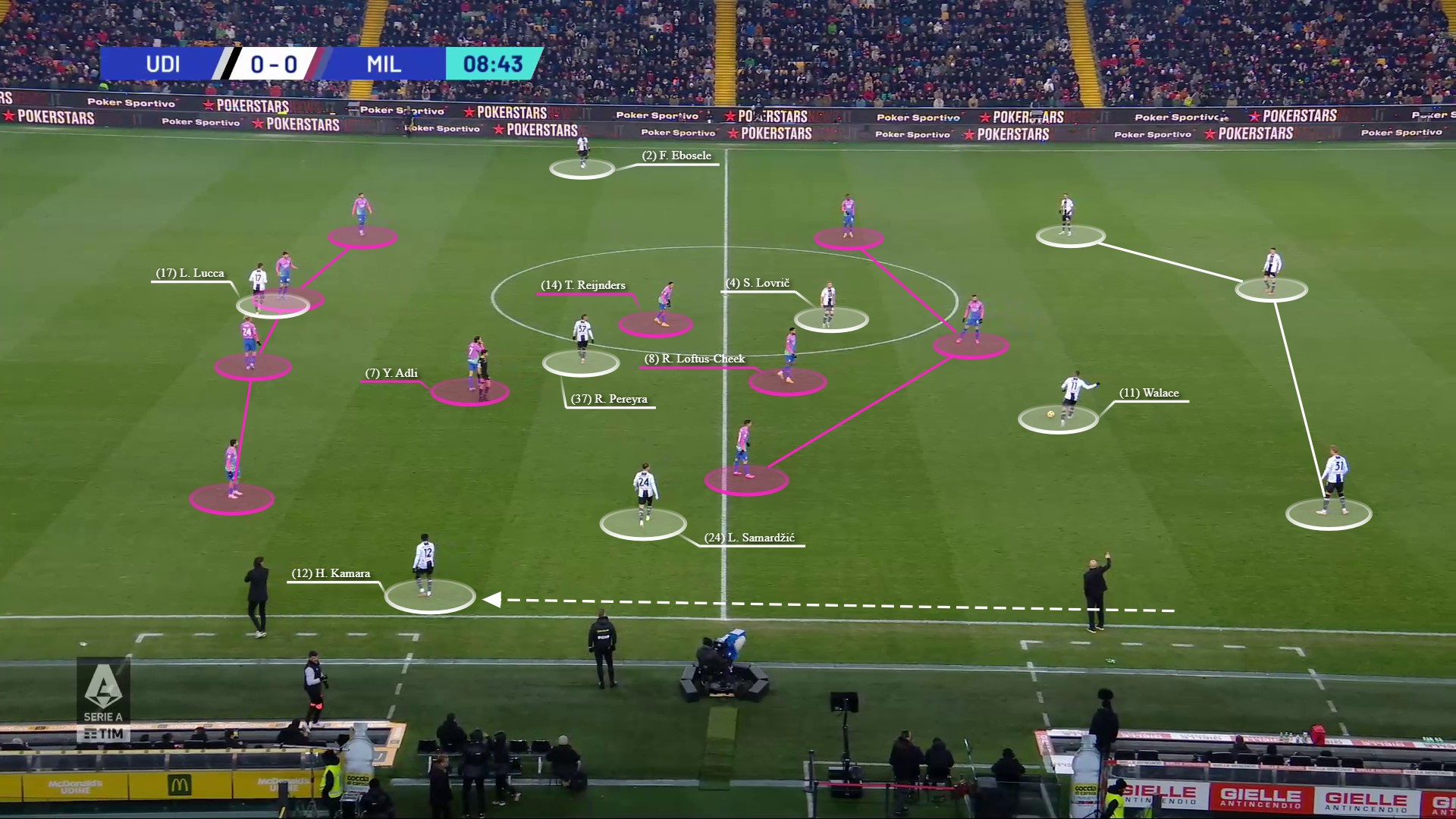
Elsewhere, Festy Ebosele held the width on the right wing, and Roberto Pereyra would drop deeper to create potential numerical and positional overloads in midfield areas.
Walace sat as the deepest Udinese central midfielder whilst Sandi Lovrić and Lazar Samardzic pulled into wider areas during build-up phases and advanced to support attacks in the final third.
From a Milan perspective, out of possession the away side’s shape can be best described as a back four, with the three central midfielders ahead in a stacked 2-1 substructure (in essence mirroring the Udinese three midfielders, but not necessarily man-marking).
Positioning Loftus-Cheek slightly higher in central areas also provided Milan with an attacking transitional threat, where they could utilise his ball carrying ability – as happened multiple times in the opening ten minutes.
As the home side predominantly kept their back three and Wallace behind the ball when attacking, the three Milan forwards could ‘cheat’ in defensive phases by staying in rest attack positions – although Pulisic was often required to drop deeper to support his midfield unit.
In reality, however, Milan had 67% of possession in this fixture. Therefore, much of the play revolved around how they intended to cause problems against Udinese’s defensive organisation.
Creating gaps in the opposition backline
In the reverse of this fixture earlier in the season at San Siro, Milan struggled for ideas on how to break-through the resolute Udinese defence and ended up losing 1-0. Part of the Rossoneri’s success in this victory, however, was frequently creating gaps in the opposition backline that could be, and were, exploited.
As we’ll see in the following examples, this ‘success’ came through a combination of Milan effectively executing their offensive gameplan and, at times, poor defending from Udinese. Although, it can be argued that Milan’s play forced situations which contributed and led to these ‘errors’ in judgment.
Let’s kick off with an example which started at the end of the 11th minute. Milan had just attempted a counterattack which Udinese had cleared and now the away side were back in possession and facing a reorganised 4-4-2 block.
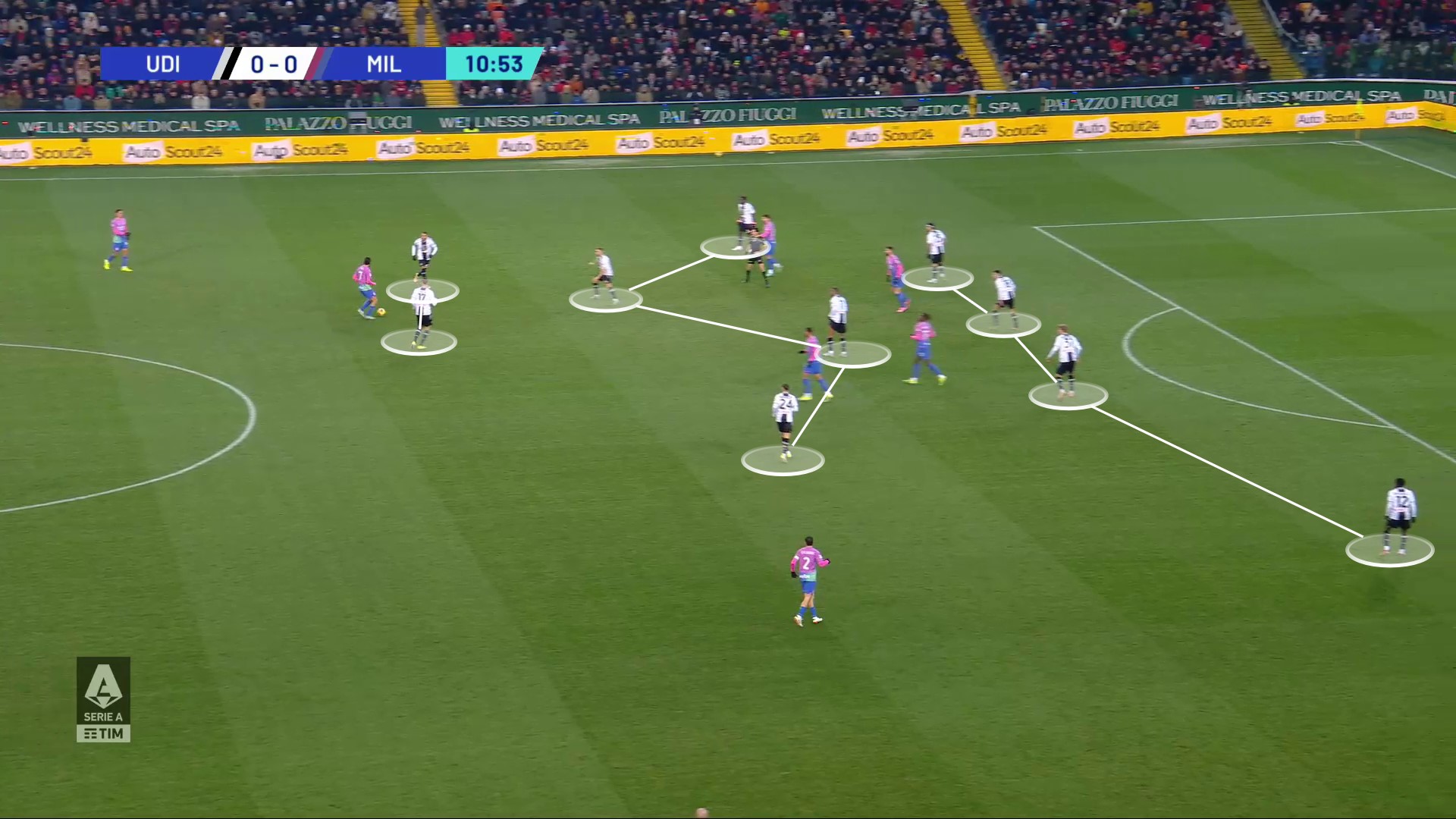
As per much of Milan’s play, with central progression initially blocked, they switched possession from one side of the pitch to the other in an attempt to create new gaps inside the Udinese shape.
As the visual below also highlights, with the Udinese midfield line focussing on the ball and opponents in front of them, Loftus-Cheek’s positioning in between the lines (e.g. on their blindside) meant that the Udinese left-sided centre-back, Thomas Kristensen, was tasked with covering. This consequently created a gap in the opposition backline for Milan to exploit.
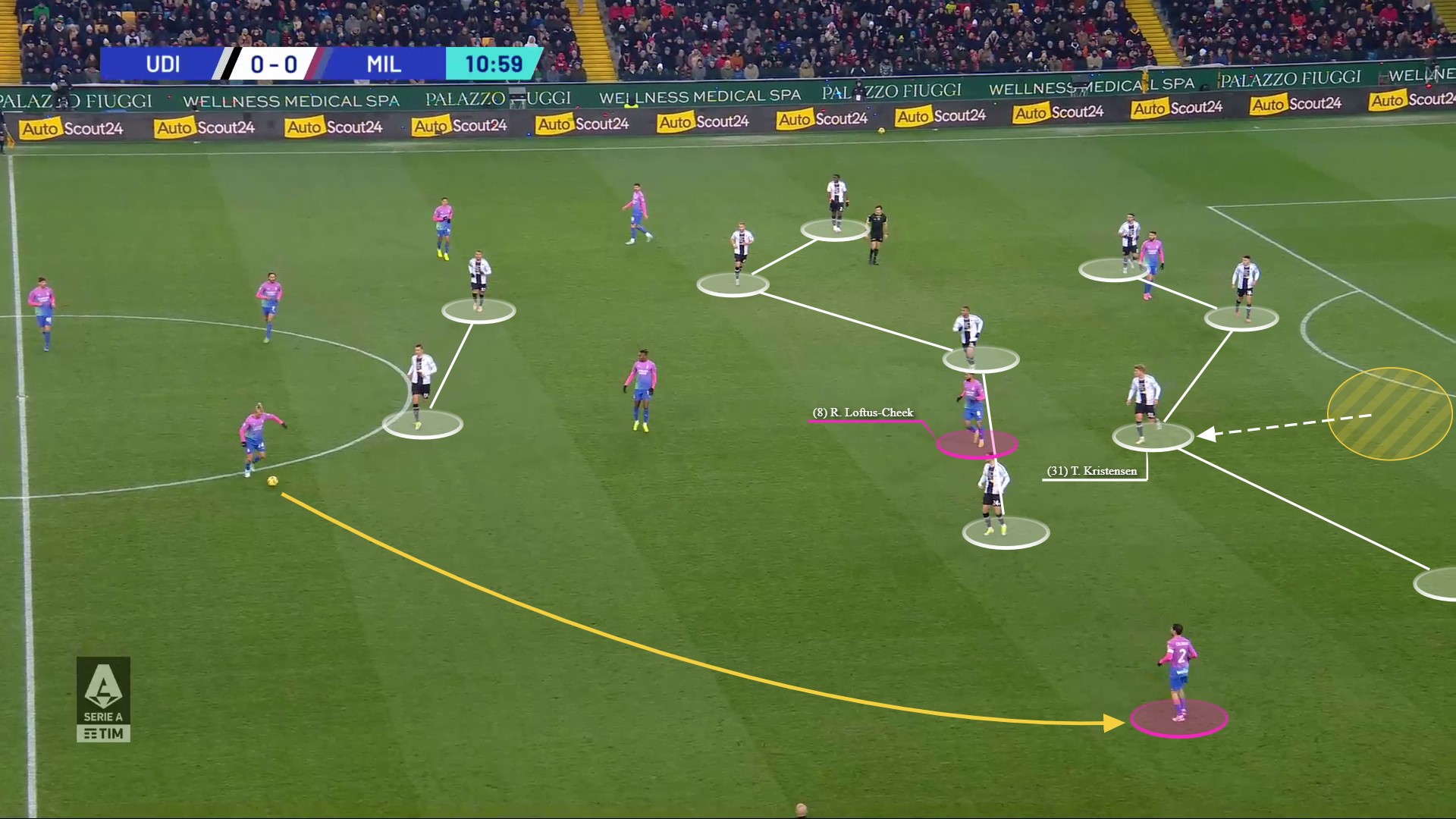
Which the visitors did courtesy of Calabria’s pass and Pulisic’s diagonal out-to-in run. It is worth noting that Udinese full-backs were tasked with staying tight to the opposition wide forwards but the consequences of this were that it a) helped exacerbate gaps in the backline and b) made it possible for the forwards to spin past, if they timed their movements well.

Despite initially being dragged out of the backline, Kristensen managed to recover in this instance and intercept the ball before Pulisic could reach it to concede a corner kick.

One final observation to make from the sequence above is Loftus-Cheek’s position in the last image. The midfielder was in space on the edge of the box, goalside of the Udinese midfield line and in front of the backline who had been dragged towards their own goal.
As seen, the mere presence of Loftus-Cheek operating in the pockets of space in behind and in between the opposition midfield line could cause Udinese issues even without the midfielder touching the ball.
But Milan could vary the threat and link-up player between the lines, with Giroud also well equipped to play that role, as showcased via the sequence below from the 18th minute.
Here, in addition to Milan utilising Giroud’s link-up skill, the away side demonstrated a few other in possession / attacking tendencies they repeated throughout the match.
Firstly, their centre-backs taking advantage of the Udinese forwards prioritising blocking central areas to progress the ball in wider areas. Calabria’s advanced positioning also contributed to this aspect.

Another feature, and outcome of Calabria pushing higher during build-up, is that it allowed Adli to pull out into the right-back slot where he could get on the ball in space and facing forwards.
Remember, the Udinese forward line tried to block access into the Milan double pivot so this was a solution they used to get their more talented players on the ball.
The action picks up below with Adli on the ball in the right-back zone. On the right wing, Calabria’s presence had forced Kamara to pass on Pulisic to Kristensen causing the Udinese backline to adjust.
Adli played a line breaking pass into the feet of Giroud who switched roles with Loftus-Cheek to offer an option between the lines.
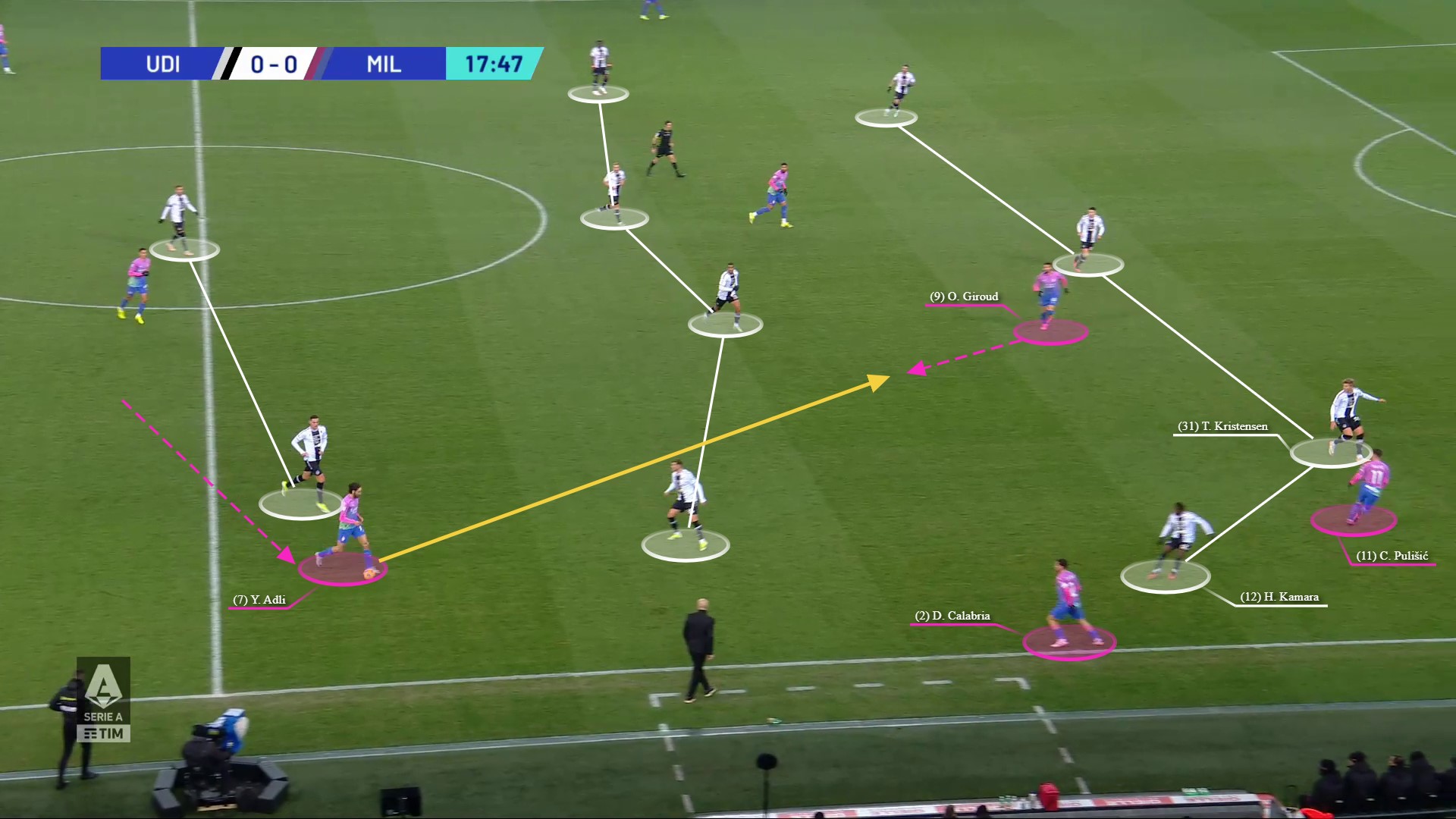
Giroud then laid a first-time pass into the path of Pulisic who had continued his lateral movement infield.
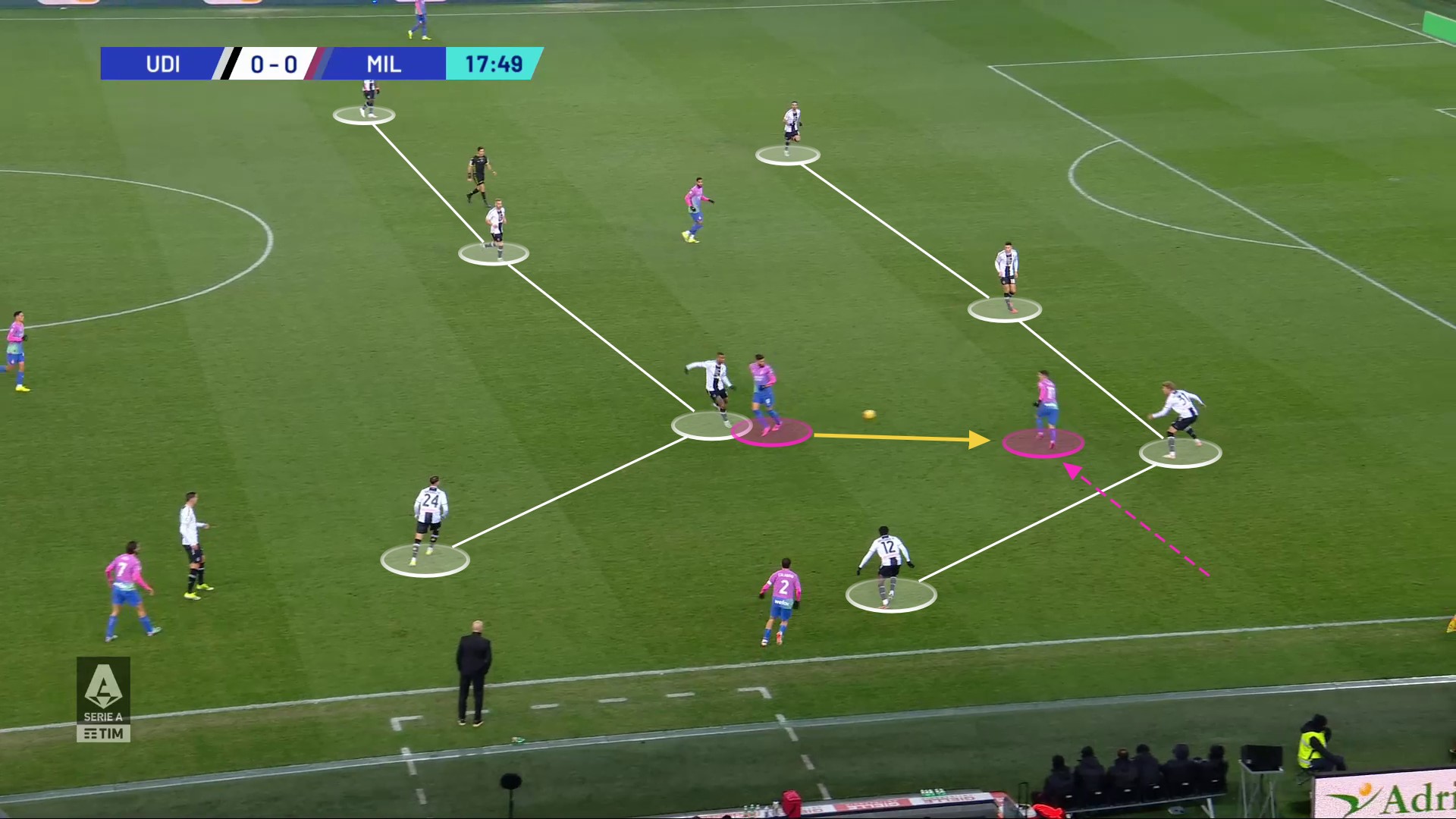
From here, the USMNT carried the ball horizontally before recycling possession backwards to Reijnders who immediately passed onto the advancing Theo Hernández.
Away from the ball, Giroud had spotted that gap in the Udinese backline (black circles), due to Kristensen following Pulisic’s carry, and signaled to make his teammates aware he wanted the ball.
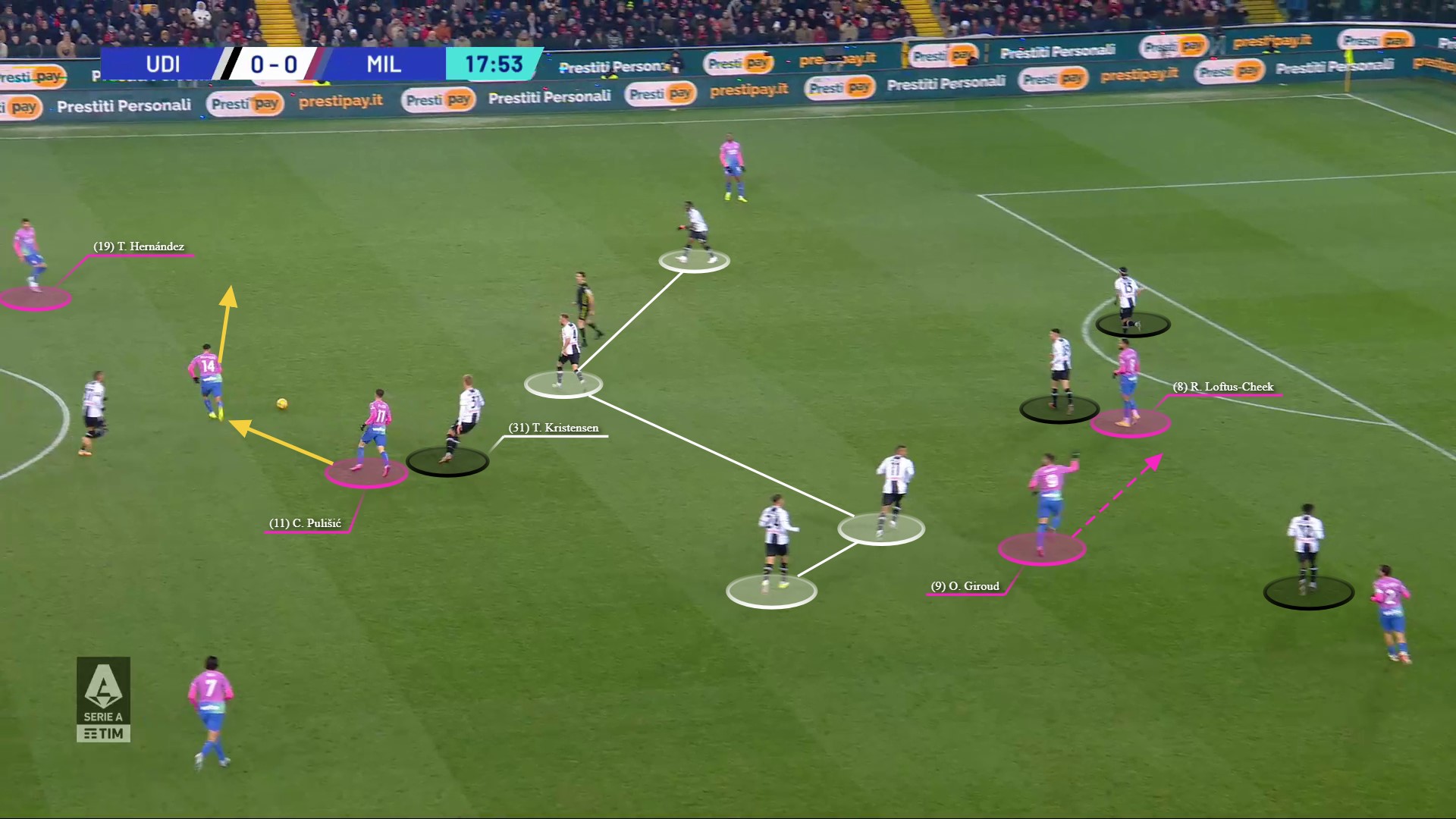
Theo Hernández duly obliged with a cross into the box to meet Giroud’s blindside run, in behind Nehuén Pérez, and into the space Kristensen had vacated in the backline.
Fortunately for the hosts, however, the French centre-forward failed to get sufficient contact on the cross to trouble their goalkeeper.
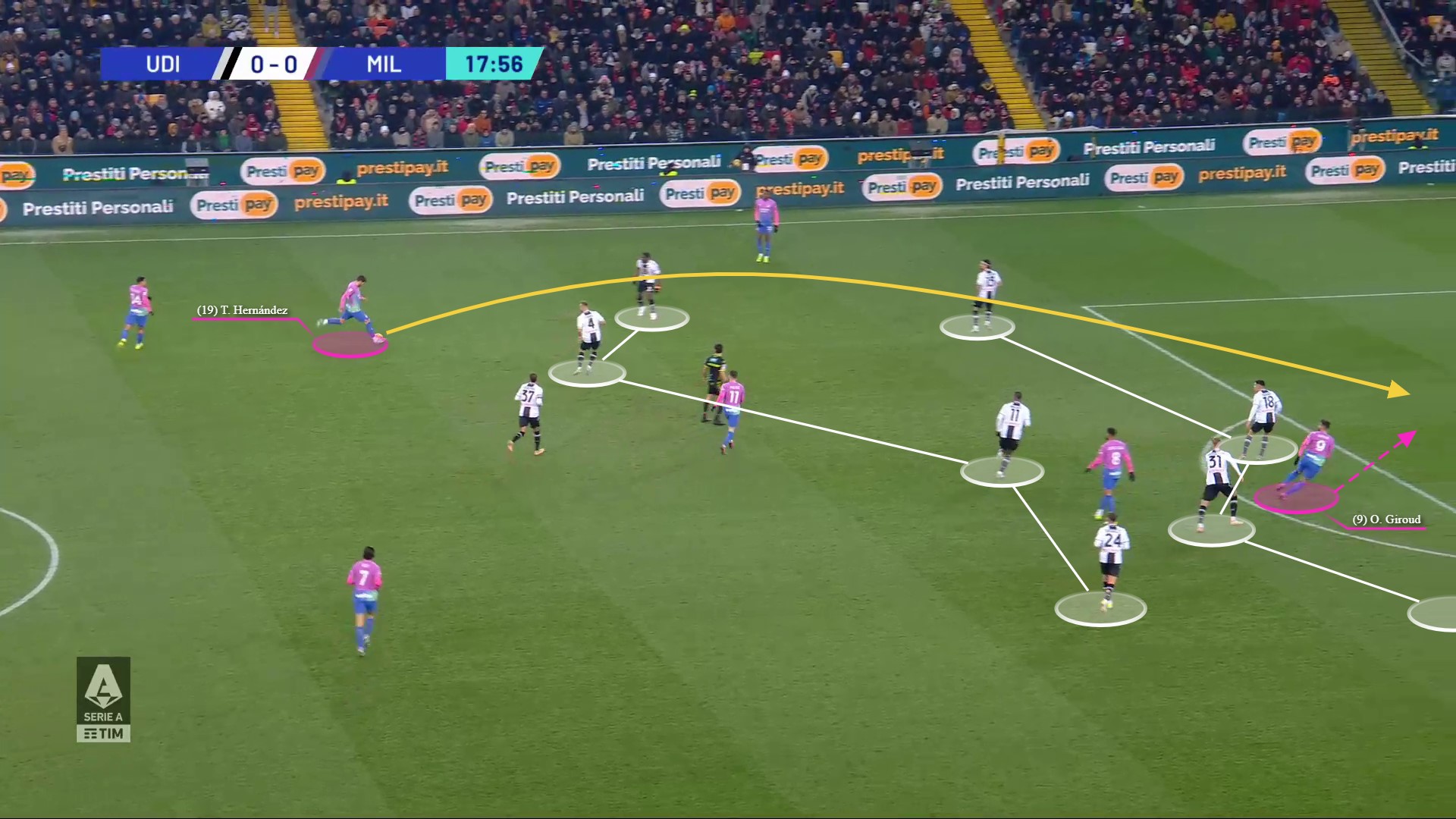

Part of the problem for Udinese was their 4-4-2 formation allowed for this weakness between the lines. Even though it was clear that Kristensen was tasked with jumping out of the backline to cover this threat on occasions – as seen below where Loftus-Cheek dropped in build-up which enticed the centre-back to follow all the way up to the halfway line – he could / would not always perform this duty.
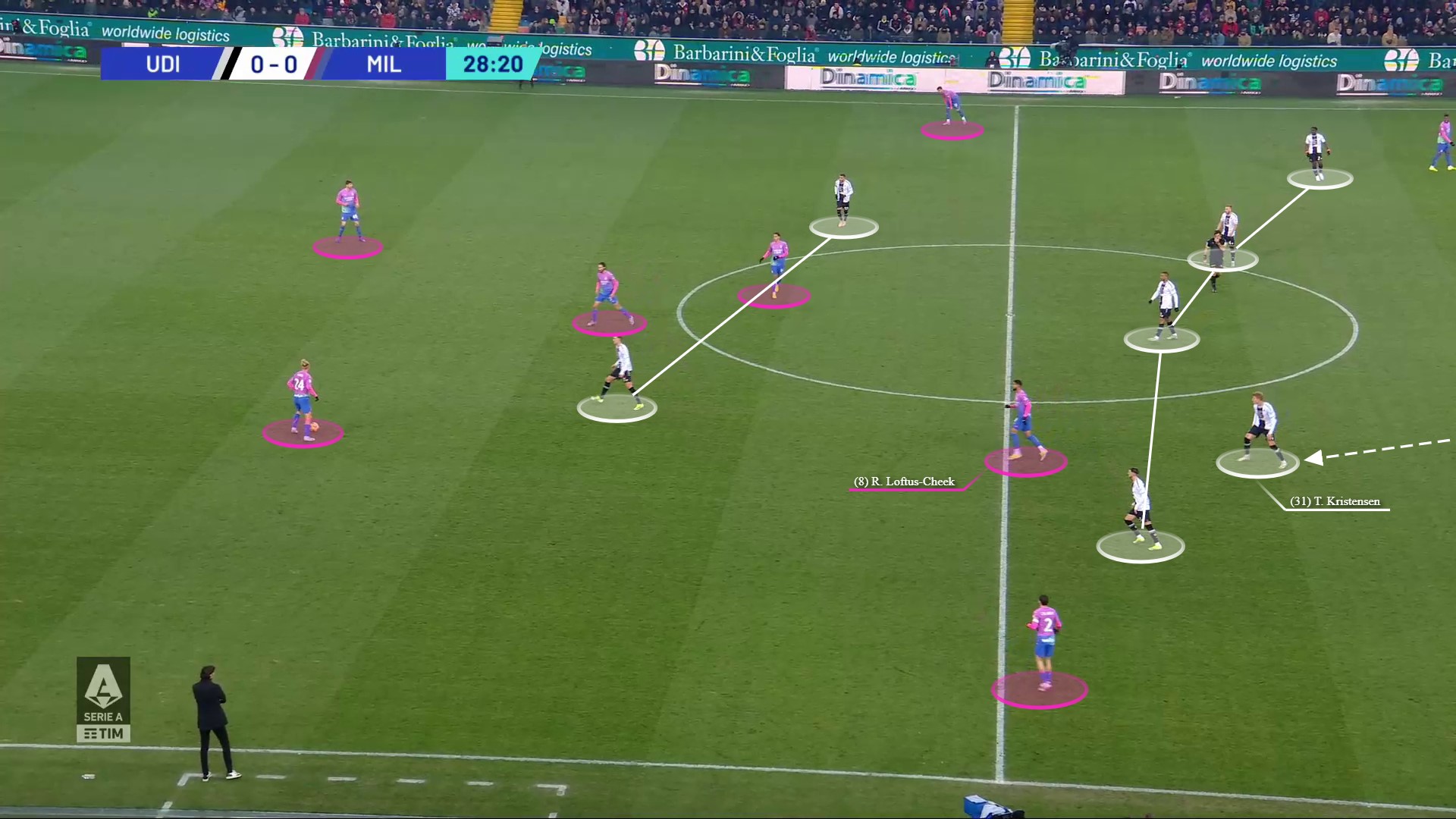
Therefore, when Udinese decided to keep their backline intact, and leave Loftus-Cheek unattended, a new issue arose for the home side: which of their midfielders would pick up the Milan man?
This exact issue manifested itself in two scenarios in quick succession on the half-hour mark. Firstly, in the passage of play below, Milan faced a settled 4-4-2 block. A few of the visiting players had interchanged positions in this sequence, namely Leão (infield) and Theo Hernández (wide left).
In an example of both Loftus-Cheek being untracked and poor Udinese defending, Milan were able to easily play through the opposition midfield unit and into the feet of Giroud…
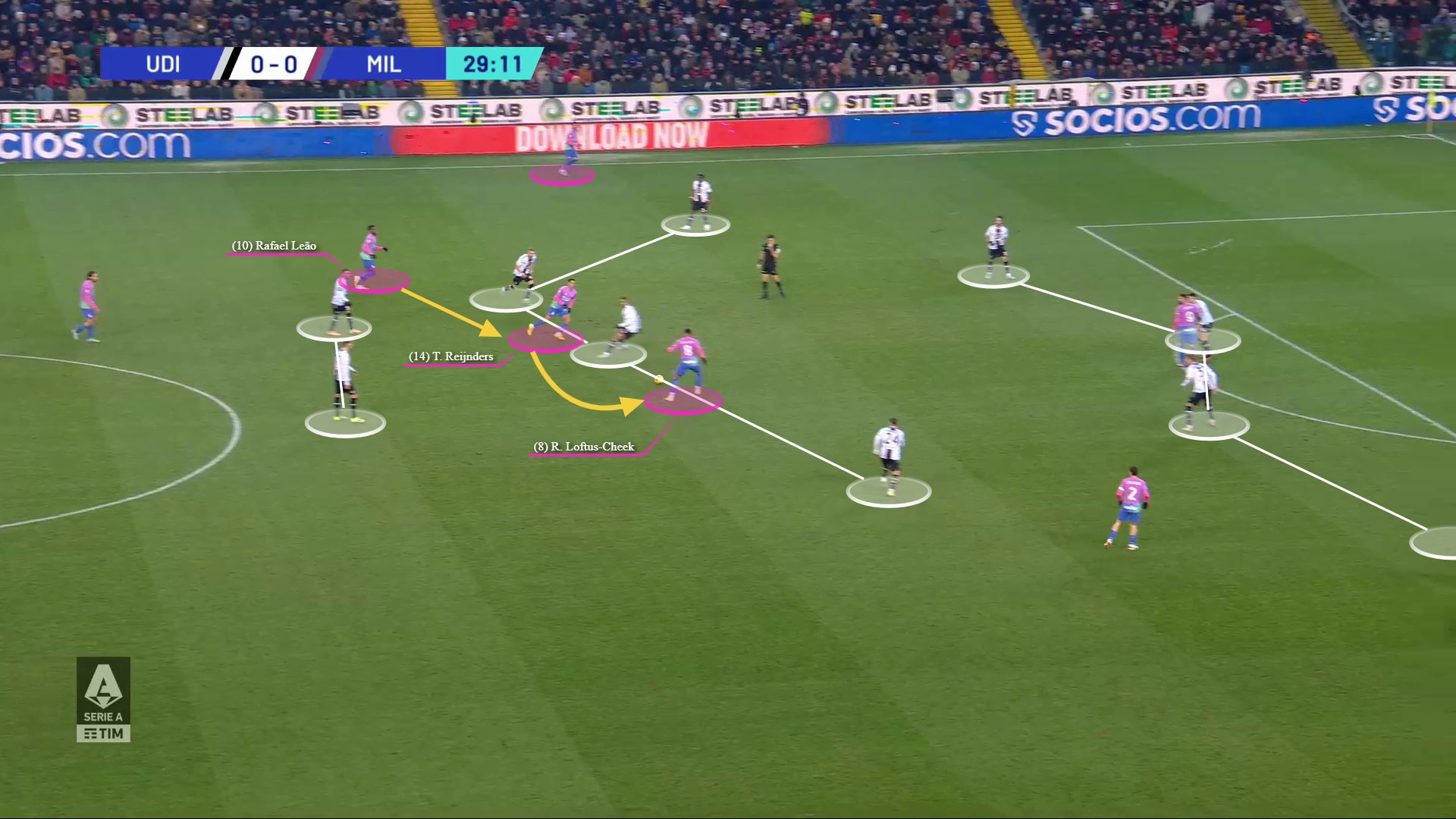
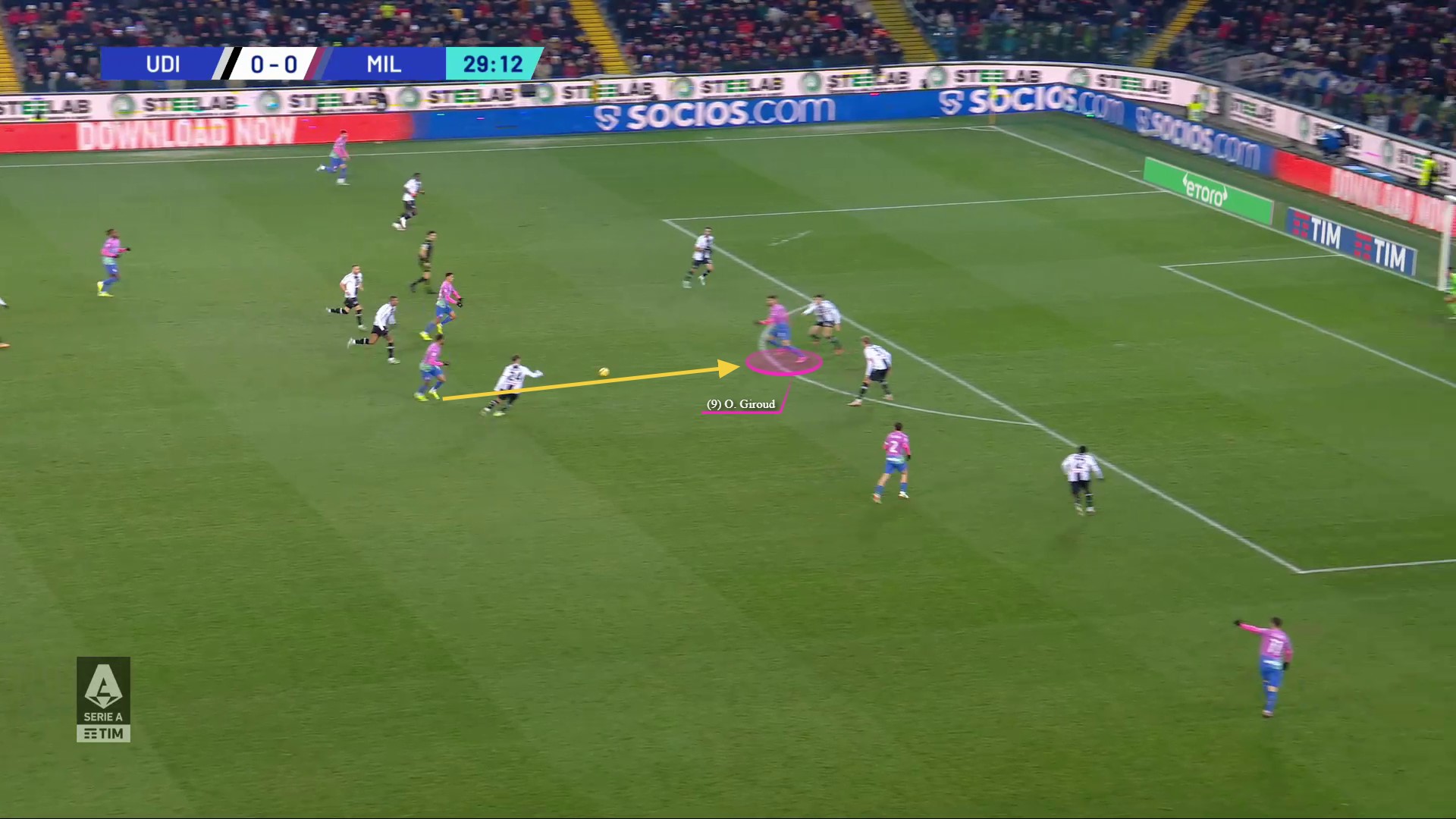
…who flicked the ball into the path of the advanced Reijnders. Due to Theo Hernández’s wider starting positioning, he was able to make a blindside run in behind the sleeping Festy Ebosele to receive the ball inside the penalty area…
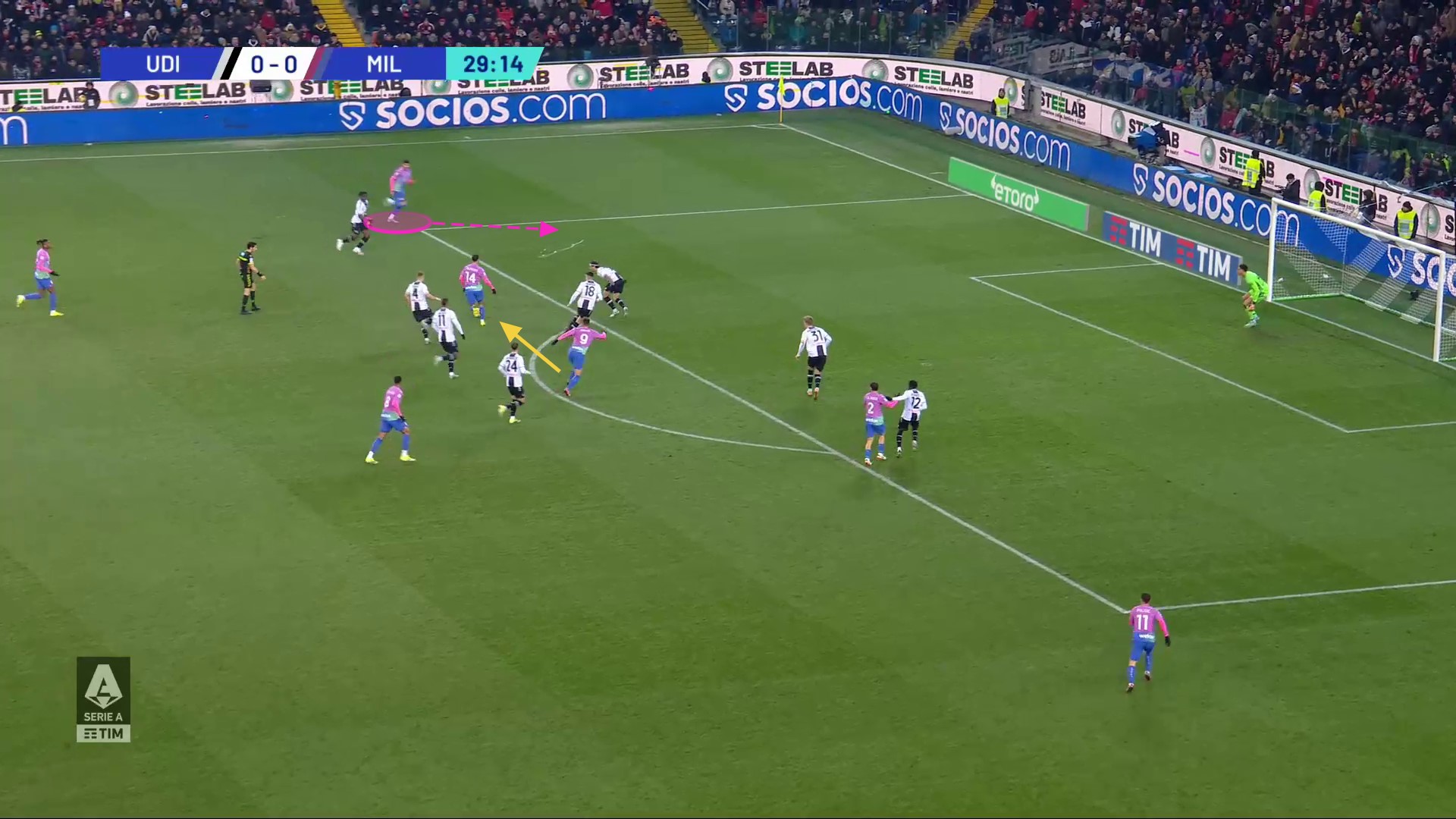
…where he attempted a cutback for Giroud – in space, goal side of the opposition midfield and in front of the retreating backline – but the cutback was played behind his international teammate and this golden opportunity went to waste.
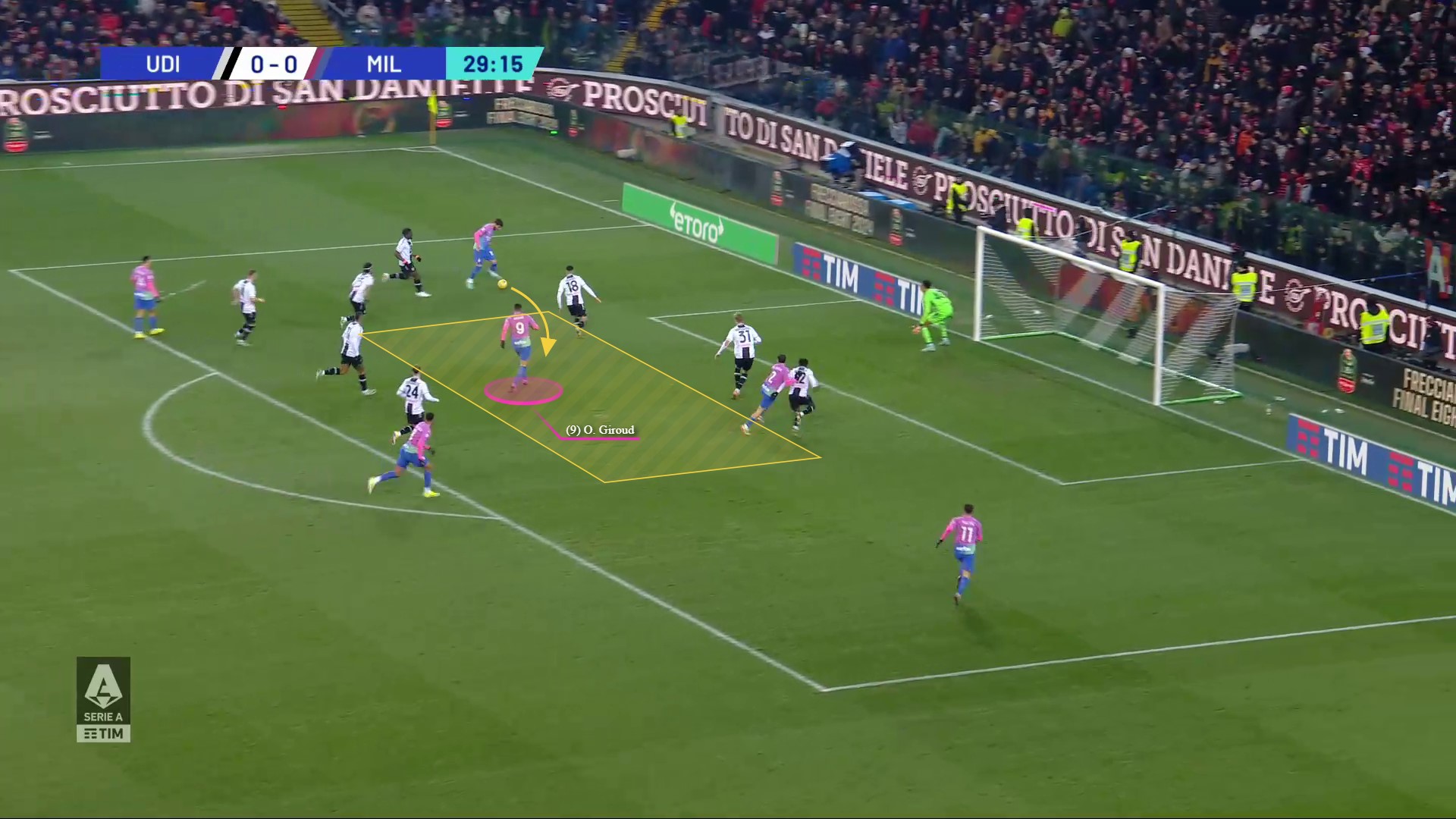
But the Rossoneri faithful feared not, as just over a minute later, a near identical attacking moment was recreated.
This attack started with Udinese again in their 4-4-2 block and Leão holding the width on the left which dragged João Ferreira out too – thus, creating a gap in the Udinese backline (yellow circle).
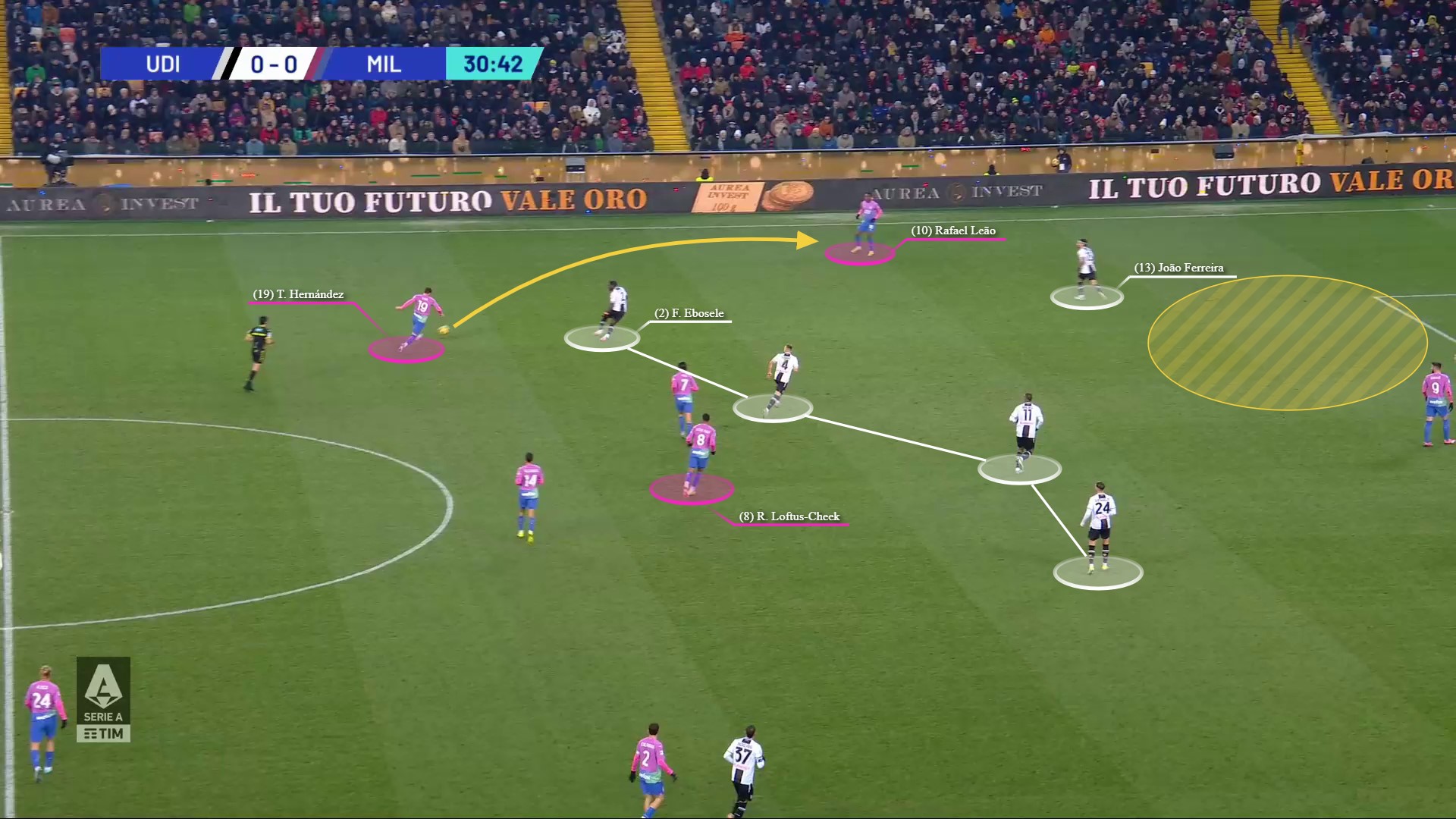
After passing the ball to Leão, Theo Hernández continued his forward momentum with an underlapping run into the vacated space in the Udinese defence. Festy Ebosele, again not covering himself in glory, was late to react and allowed the Milan left-back to get goal side…

…and received the ball inside the box where he attempted another cutback. This time, it was perfectly set for a team-mate to strike, with Loftus-Cheek completely unmarked – and in the now familiar space of being goal side of the midfield line and in front of the retreating backline – to side-foot in to make it 1-0.
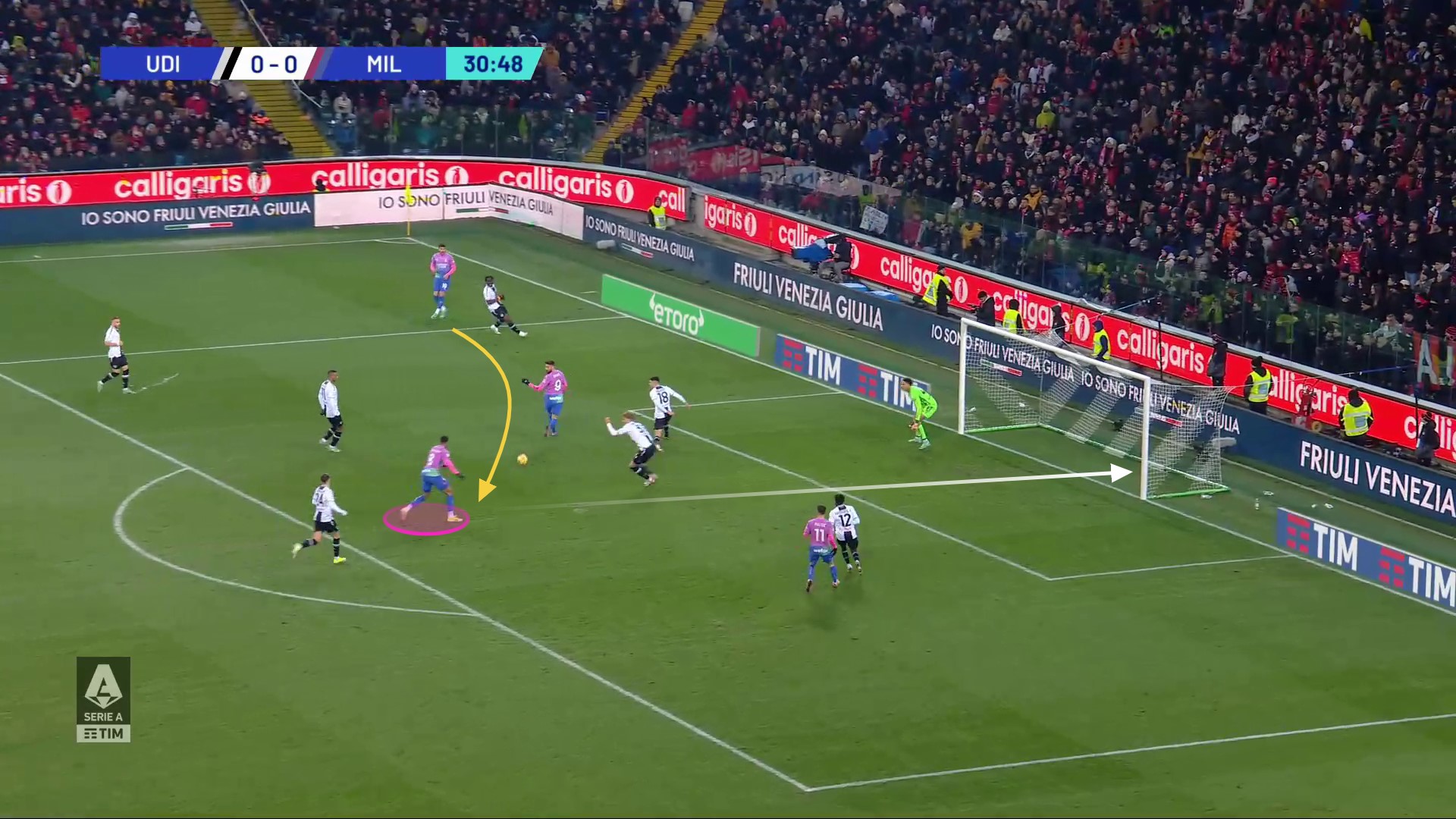
In the second half, there were less examples of Milan using this tactic, as the away team struggled to manipulate the opposition as effectively – with a factor being that Udinese took the lead on the 62nd minute so were more willing to sit deeper and stay connected.
However, Milan’s equaliser in the 83rd minute had an all-too-familiar look about it. Play started on the Milan right-hand side with possession worked over towards the left – see Milan’s build-up base of six helping to circulate the ball and bait their opponents.
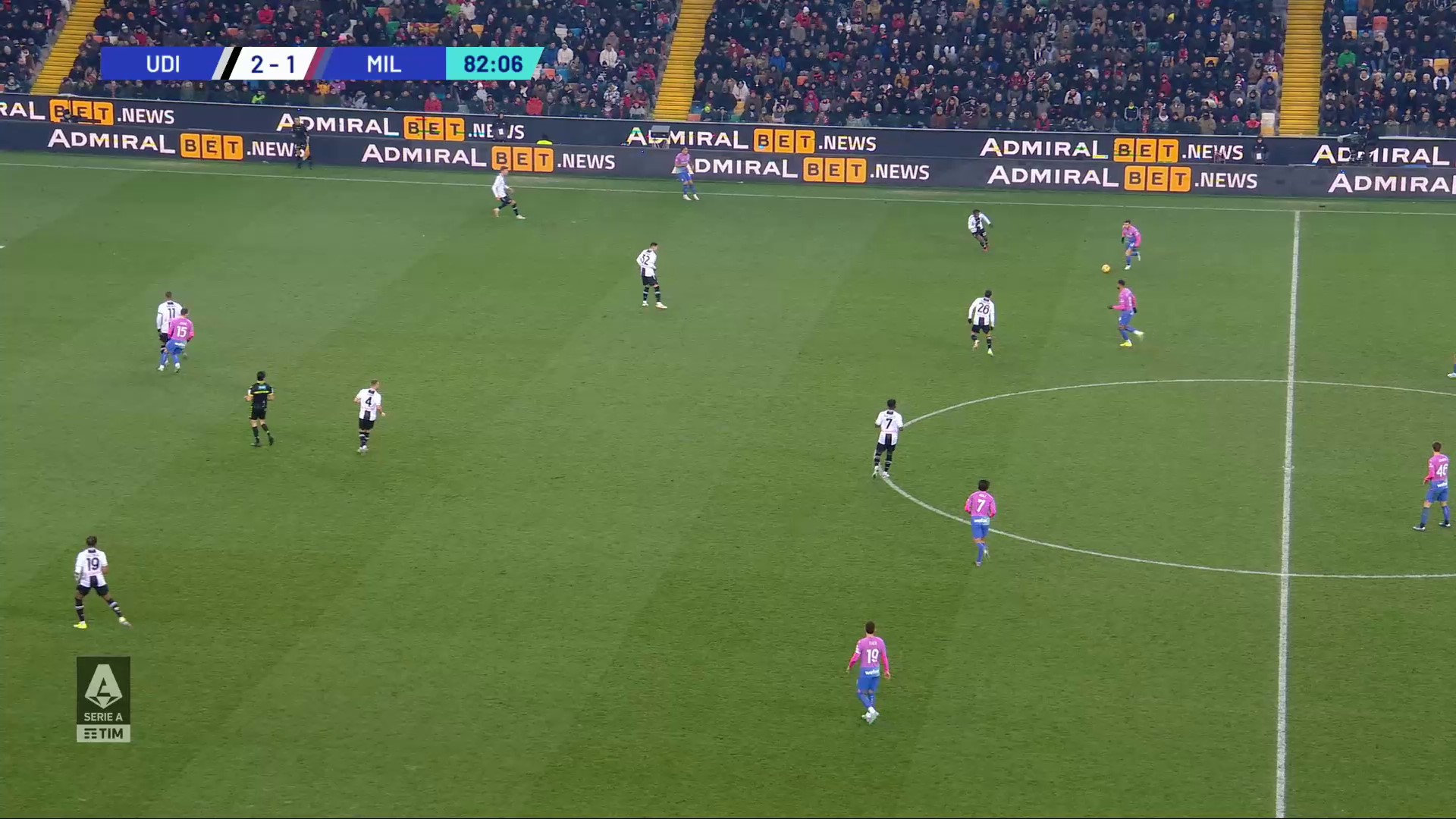
A pass to Theo Hernández drew out Kingsley Ehizibue, a substitute for Festy Ebosele. (After multiple substitutions, the home team were now switching between a 4-4-2 and 3-5-2 defensive system).
Milan then worked the ball back infield before a pass was made out wide to Leão which subsequently attracted João Ferreira.
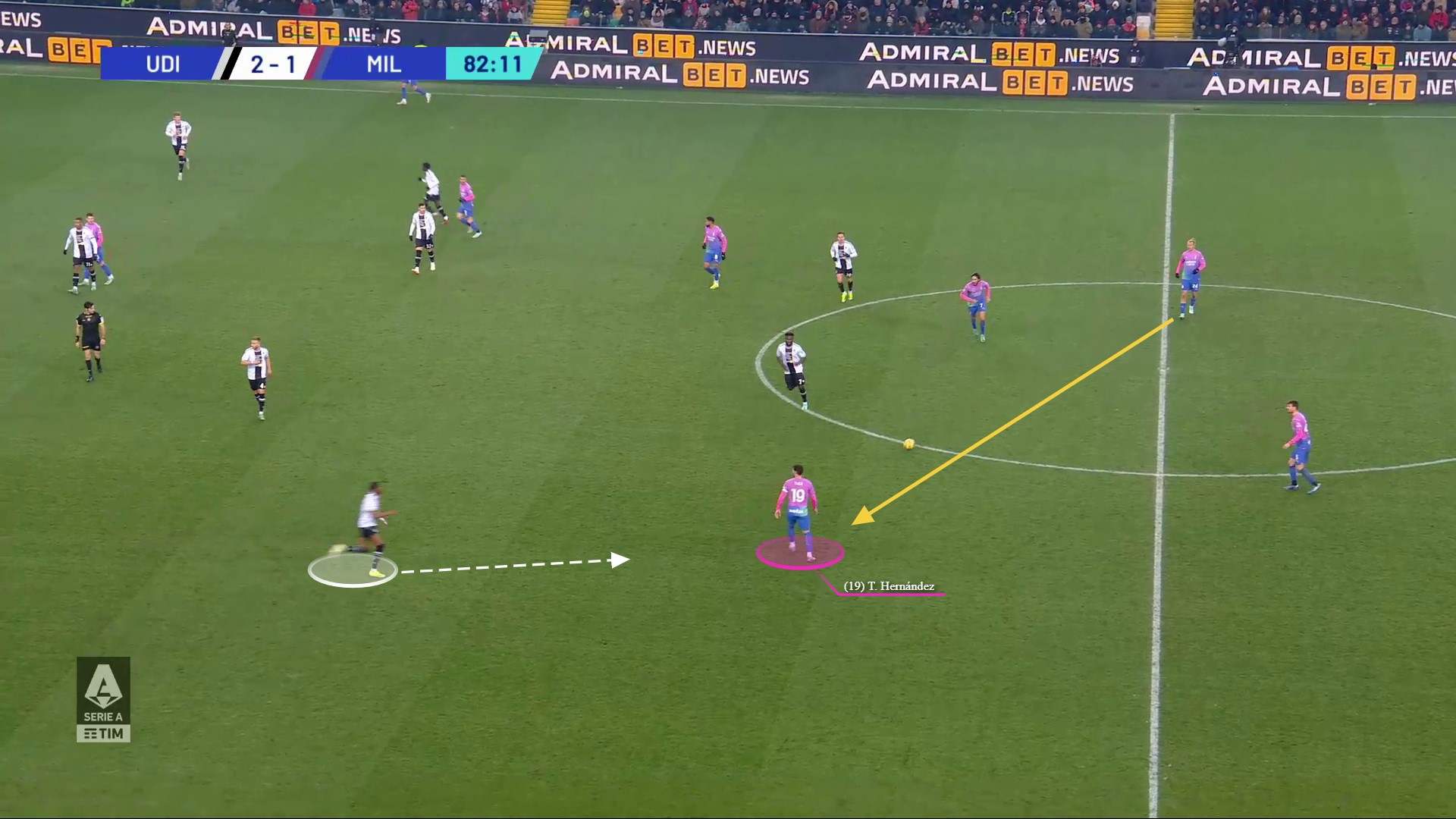
With Milan now playing both Giroud and Luka Jović, both Udinese centre-backs are occupied and a gap has appeared between them. Theo Hernández, who continued his forward run infield, spotted this opportunity and signaled for the pass in behind which Leão saw and executed.
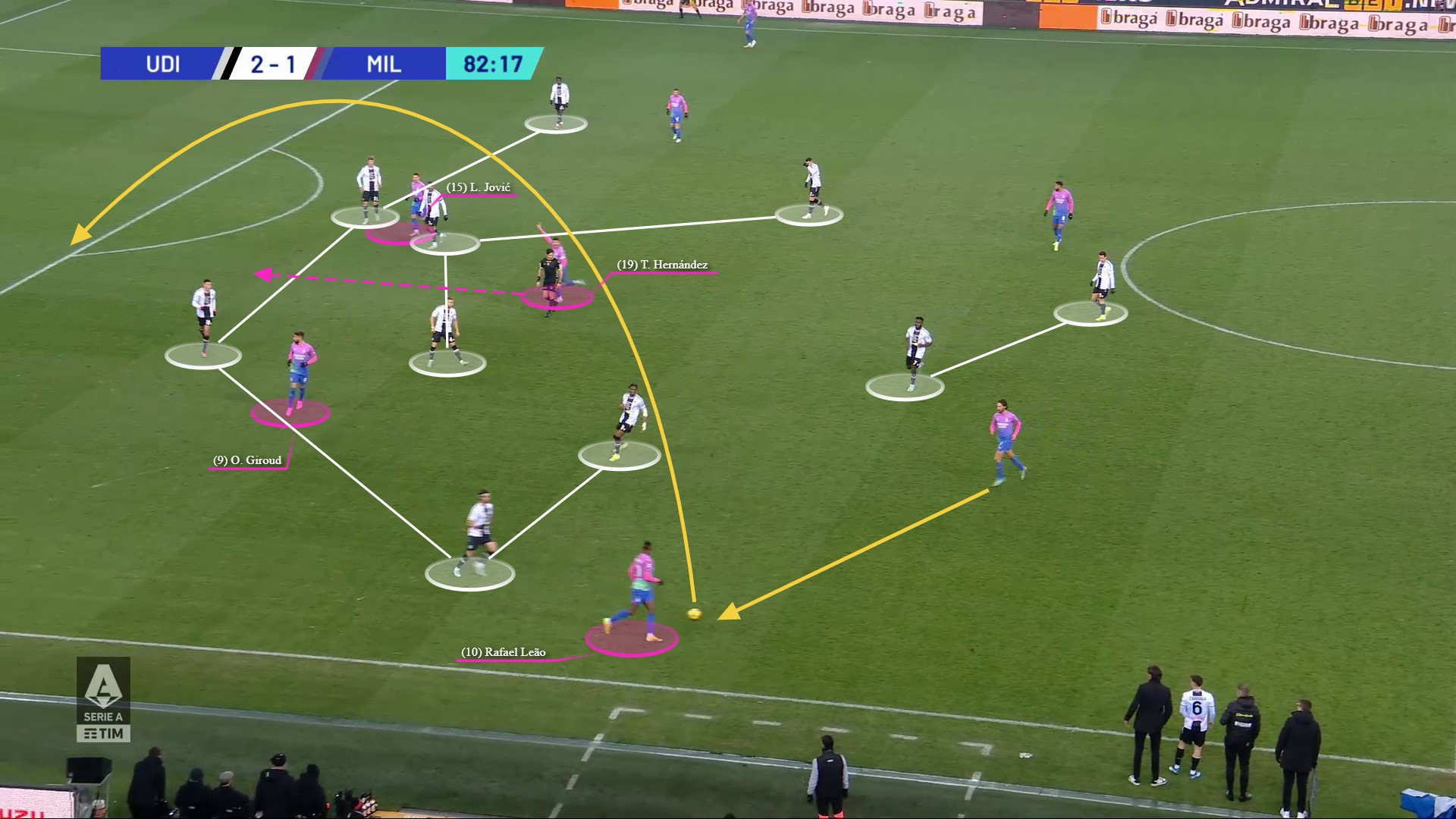
The Udinese midfielders were late to spot this threat – and much like the first half problem of Loftus-Cheek, they looked unsure as to whose responsibility it was to track the free player.

The outcome, Theo Hernández received inside the box before crossing. A loose ball was shot by Giroud before Jović was first to react to the rebound to head in and make it 2-2. Milan went onto win the game in the 93rd minute, scoring from a corner kick – where Pioli’s side again benefitted from positioning a player towards the far post.
Conceding goals and allowing shots against continues to be an issue for Milan. But on this occasion, aspects of their offensive gameplan proved to be effective in scoring the goals which led to their victory.
Next up
From a footballing perspective, the Milan focus now switches to Bologna at home in a week.
However, everyone’s full focus, including the relevant authorities, should be on supporting Mike Maignan and handing out stronger punishments for those responsible in the unacceptable events which occurred during this tarnished win.

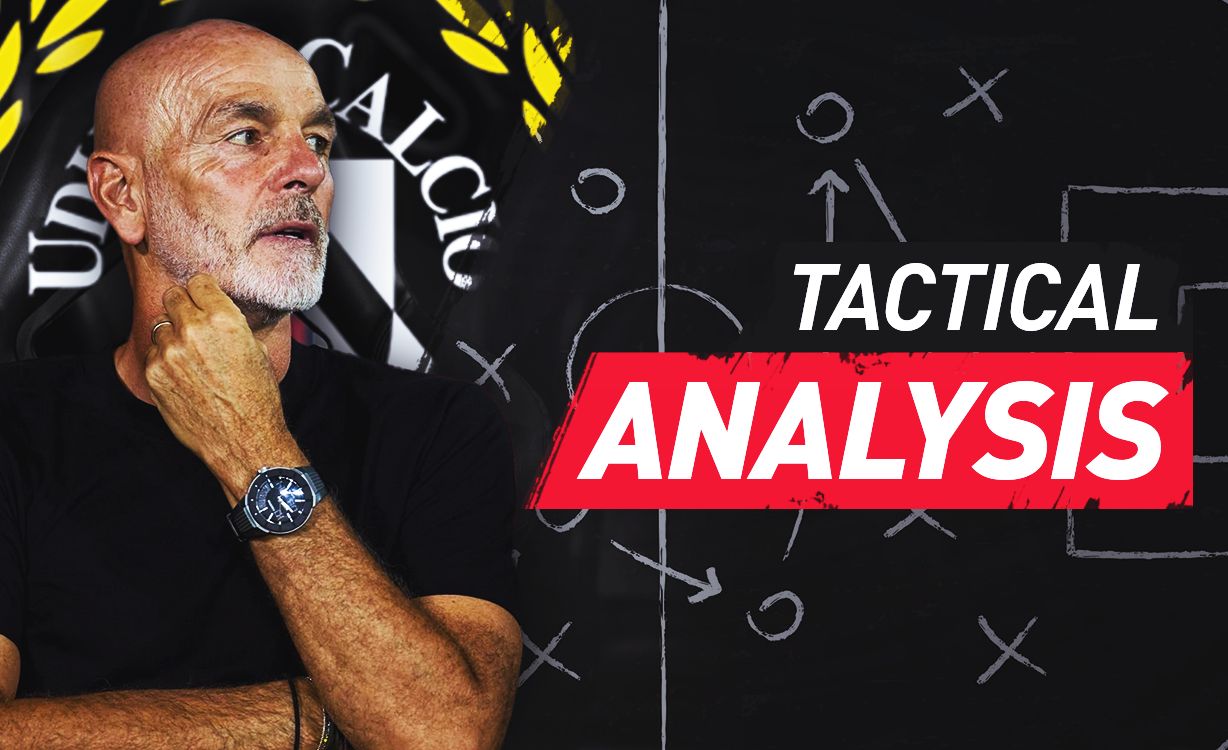
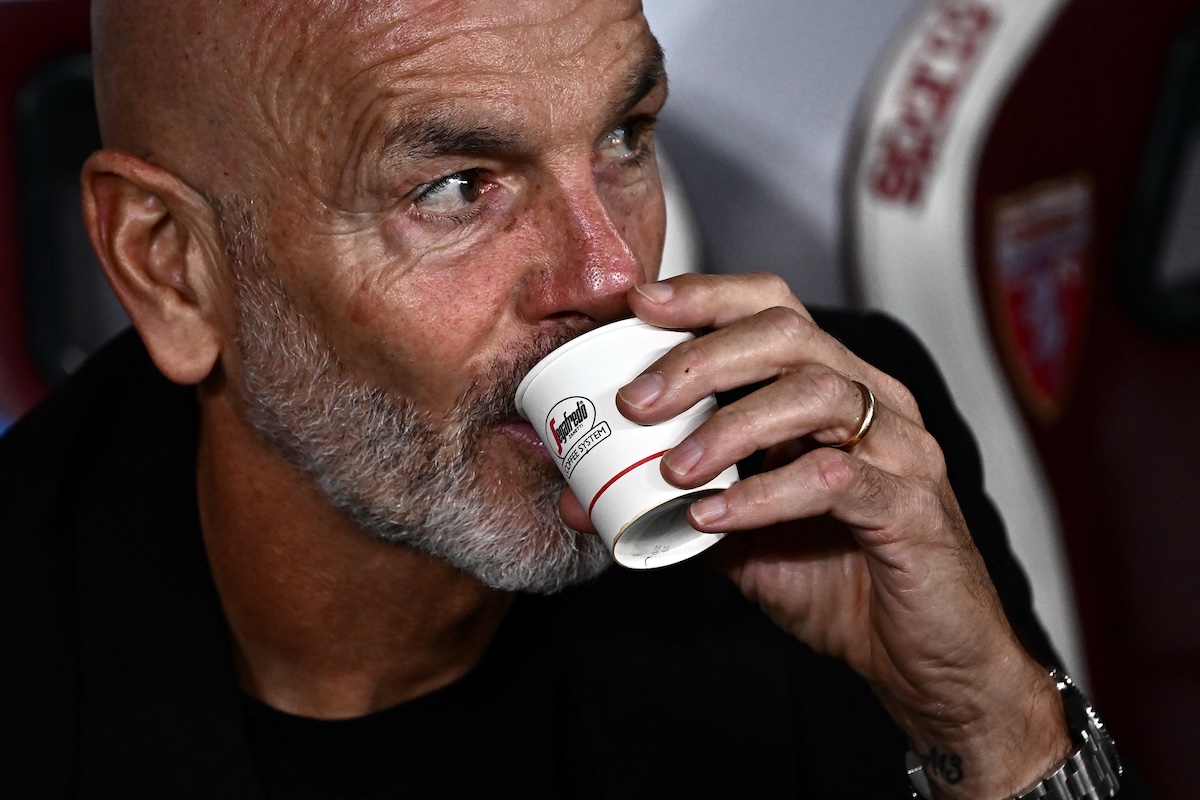
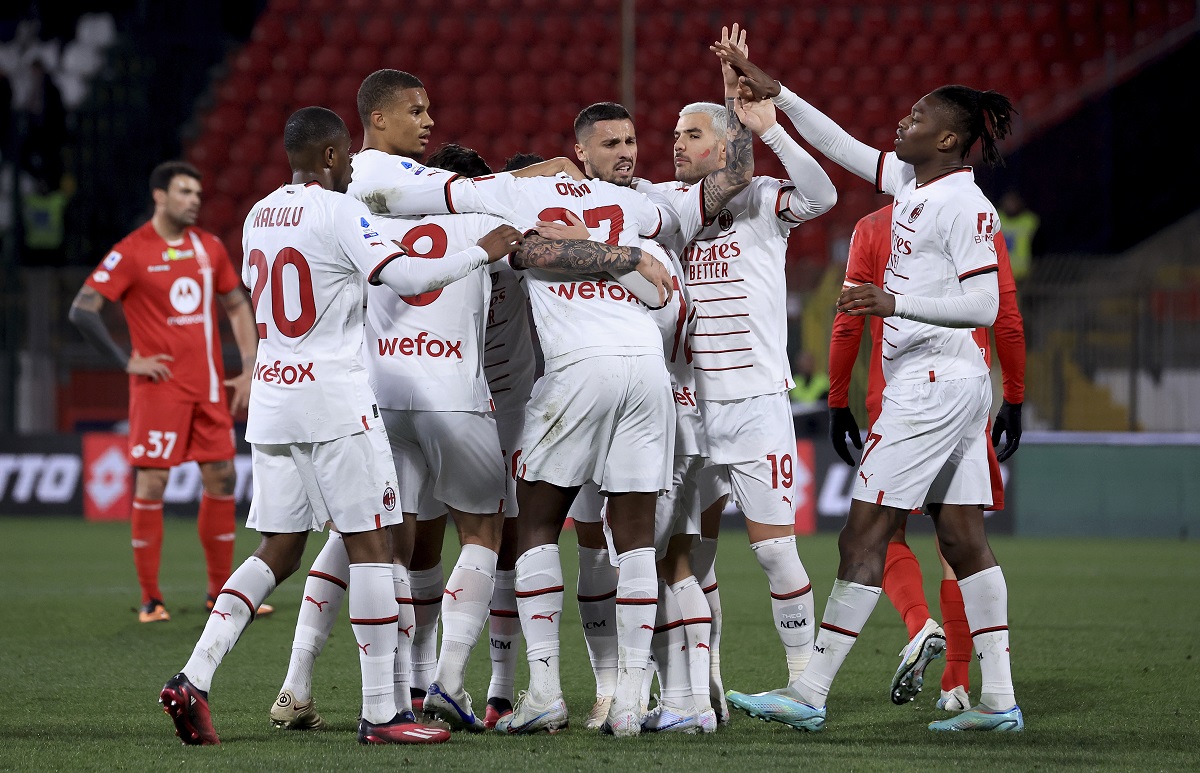
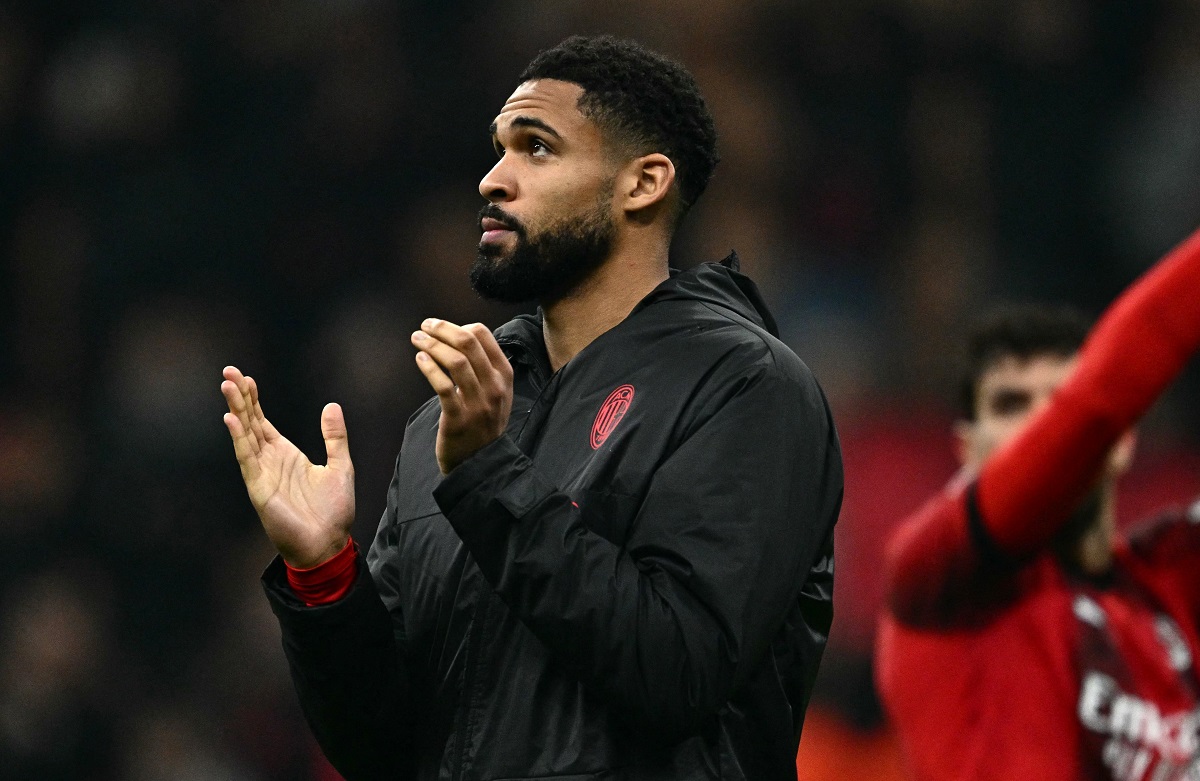
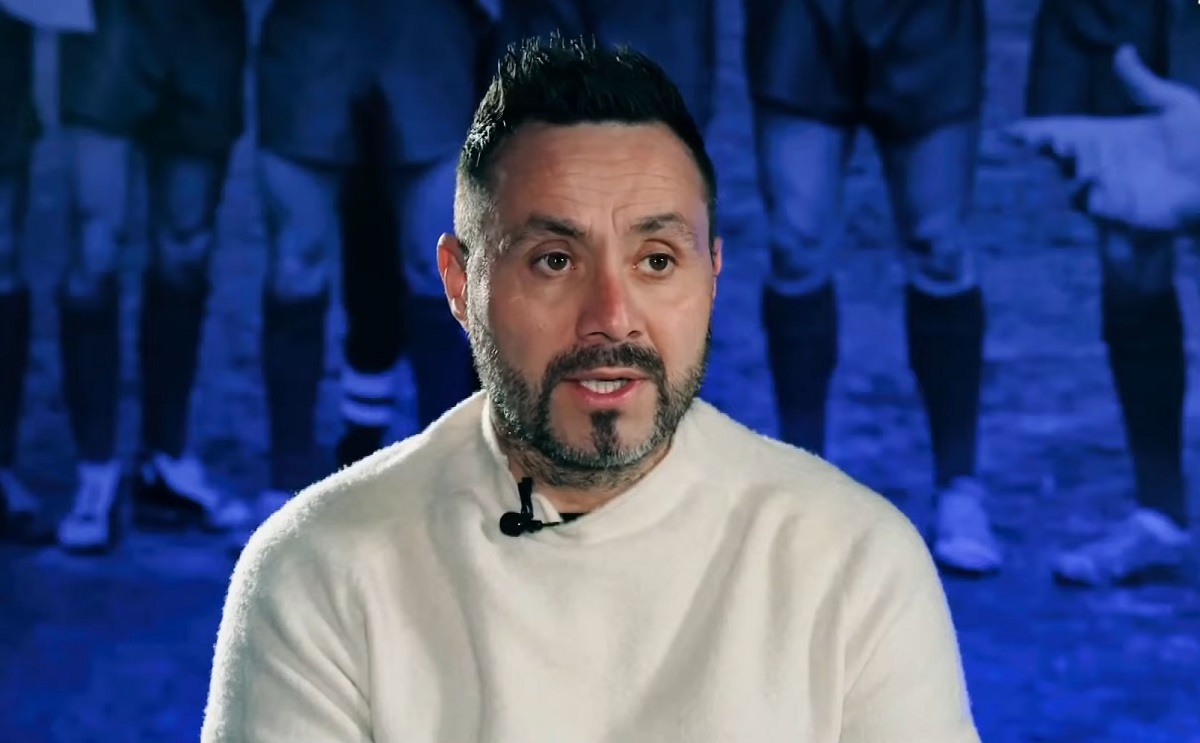
Hey look, My perfectly reasonable comment was deleted. Yay censorship. Care to explain?
Pioli’s tactics exploited udinese’s 4-4-2 set up decently